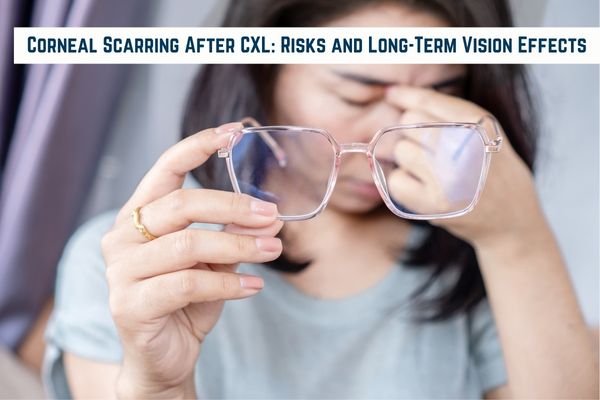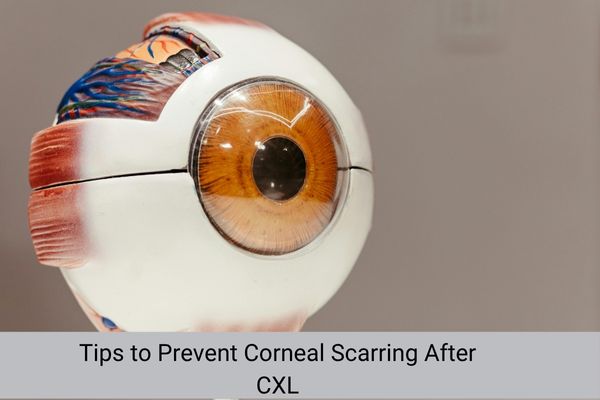Objective:
The objective of this article is to explore the risks of corneal scarring following corneal crosslinking (CXL) surgery and provide essential insights on how to prevent them. With the increasing popularity of corneal collagen crosslinking as a treatment for conditions like keratoconus, it is important to understand how corneal scarring may affect post-operative recovery and vision. This article provides an in-depth analysis of the factors contributing to corneal scarring, ways to minimize risks, and the role of follow-up care.
Testimonials
“I have seen Mr. Nanavaty Several Times, and he is always very professional and friendly”
Understanding Corneal Scarring and Its Impact on Vision
Corneal scarring can have a significant impact on vision, especially after corneal crosslinking (CXL) surgery. The cornea is the transparent outer layer of the eye and when it becomes scarred, it can lead to blurred or distorted vision. For patients undergoing corneal collagen crosslinking, understanding the potential risks of scarring is crucial for ensuring the best possible recovery.
In general, corneal crosslinking involves applying ultraviolet light to the cornea after riboflavin (Vitamin B2) is applied, which strengthens the corneal collagen fibers, enhancing the cornea’s structure and reducing the progression of diseases like keratoconus. While CXL is widely regarded as a safe and effective treatment, the formation of scarring can affect the healing process, necessitating corrective measures such as the use of lenses or even further surgeries in severe cases.

What Are the Risks of Corneal Scarring After CXL and Its Potential Impact on Long-Term Vision?
While corneal crosslinking generally offers a good prognosis for patients, there are still risks associated with the procedure, including corneal scarring. The risk of scarring may be higher in certain situations, especially when the procedure is not performed under ideal conditions.
Scarring can occur due to a variety of factors such as the depth of the treatment, the method of crosslinking used or complications during the healing process. Patients who experience scarring may notice visual disturbances such as blurred vision, halos, and sensitivity to light. In more severe cases, this could lead to the need for further treatment, including the use of corneal collagen crosslinking with a higher intensity or even a corneal transplant.
Why Do Some Patients Develop Corneal Scarring After CXL?
Several factors contribute to the development of corneal scarring after corneal crosslinking, and it is essential for patients to be aware of these factors to better manage their recovery. Some of the main reasons why scarring may occur include:
- Type of Corneal Crosslinking Procedure: There are different methods of CXL, such as epi-on and epi-off procedures. The epi-off technique, which removes the outer epithelial layer of the cornea, may have a higher risk of scarring compared to the epi-on method, which leaves the epithelial layer intact. Patients should discuss the risks of each procedure with their corneal crosslinking specialist to determine the most suitable treatment for their specific needs.
- Pre-Existing Eye Conditions: Patients who have underlying conditions like dry eye syndrome, ocular surface disease or previous eye injuries may be at a higher risk for developing corneal scarring after CXL. These conditions can impair the natural healing process, leading to delayed or irregular wound healing and scarring.
- Post-Operative Care: Proper post-operative care is essential in preventing complications like scarring. For instance, if the patient does not follow the aftercare instructions regarding eye hygiene, the use of prescribed eye drops or wearing protective eye shields, the risk of scarring can increase.
- Infection: Although rare, infection can occur after corneal cross linking and lead to scarring if not treated promptly. This risk can be minimized with proper hygiene and regular check-ups at the corneal crosslinking clinic.
How Can Patients Minimize the Risk of Scarring After CXL?
To minimize the risk of scarring after corneal crosslinking, patients should adhere to a strict post-operative care plan and attend regular follow-up appointments. Here are some essential tips:

- Follow Post-Operative Care Instructions: After CXL, it is crucial to follow the instructions provided by the corneal crosslinking specialist. This includes using prescribed antibiotics and anti-inflammatory eye drops to reduce the risk of infection and inflammation, both of which can contribute to scarring.
- Avoid Rubbing Your Eyes: Rubbing your eyes can interfere with the healing process, potentially causing complications. Patients should avoid this to ensure proper recovery and minimize the risk of scarring.
- Wear Protective Eyewear: During the early stages of recovery, wearing sunglasses or protective eyewear can prevent irritation from bright lights, dust or other environmental factors that may cause further damage to the healing cornea.
- Moisturize the Eyes: Dry eyes can exacerbate scarring, so using prescribed lubricating eye drops to keep the eyes hydrated can support the healing process.
Why Are Follow-Up Appointments Crucial After CXL?
Regular follow-up appointments at corneal cross-linking specialist, such as Sussex Eye Laser Clinic, ensures that the cornea heals properly and that any early signs of scarring are detected promptly. During these visits, doctor will examine the cornea to assess its shape and the level of healing.
Follow-up visits also give patients an opportunity to ask questions and address any concerns they may have about their recovery. If scarring is detected early, it may be possible to intervene with treatment to prevent further vision deterioration.
What Are the Signs of Corneal Scarring Patients Should Watch For?
After corneal crosslinking, patients should be vigilant in watching for signs of corneal scarring or complications that may require further treatment. Early warning signs of scarring include:
- Blurred or Distorted Vision: If vision becomes hazy or objects appear distorted, this may be a sign of scarring.
- Increased Sensitivity to Light: Heightened light sensitivity (photophobia) can occur with scarring.
- Discomfort or Pain: Persistent discomfort, pain or the sensation of something in the eye can be indicative of complications.
- Redness or Inflammation: Prolonged redness or inflammation of the eye may signal infection or other issues that could lead to scarring.
If any of these symptoms occur, patients should seek immediate attention from their corneal crosslinking clinic to prevent further complications.
How to Support Healing: Nutrition, Lifestyle, and Eye Care Tips
Supporting the healing process after corneal crosslinking goes beyond following medical advice. A healthy diet and lifestyle can play an essential role in recovery. Here are some tips to support recovery:
- Stay Hydrated: Proper hydration helps maintain the moisture level in the eyes, reducing the risk of irritation and dryness that could hinder healing.
- Consume Nutrient-Rich Foods: A diet rich in vitamin A (found in foods like carrots and leafy greens), omega-3 fatty acids (found in fish and nuts) and antioxidants (like berries) supports eye health and tissue repair.
- Rest and Sleep: Adequate rest is essential for the body’s natural healing process. Make sure to get plenty of sleep during the recovery period.
- Avoid Smoking: Smoking can slow down the healing process and impair the immune system, increasing the likelihood of complications such as infection or scarring.
Client Speaks
“Makes one feel very comfortable & at Ease. Recommended him to everyone“
Conclusion
While corneal crosslinking is an effective and widely used procedure for conditions like keratoconus, Patients must be aware of the potential risks of corneal scarring following the surgery. By understanding the factors that contribute to scarring and taking appropriate measures to minimize risks, such as adhering to post-operative care instructions, attending follow-up appointments and maintaining a healthy lifestyle, patients can improve their chances of a successful recovery and minimize the likelihood of long-term vision issues.
By seeking expert guidance from a corneal crosslinking specialist and remaining proactive in eye care, Patients can significantly reduce the risk of scarring, ensuring better vision outcomes in the future.
Author Bio:
Sussex Eye Laser Clinic, led by Consultant Ophthalmic Surgeon Mr. Mayank A. Nanavaty, offers advanced eye care solutions tailored to individual vision needs. With deep expertise in cornea- and lens-based refractive procedures, Mr. Nanavaty provides personalised vision correction solutions including implantable lenses, ipl for dry eyes and laser surgery. Each patient undergoes a comprehensive eye assessment to ensure treatments align with their visual goals. Using cutting-edge technology and a patient-focused approach, the clinic continues to lead in delivering high-quality refractive care.
